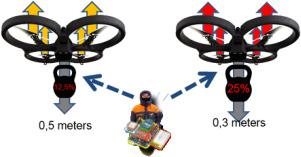Simulation Modelling Practice and Theory ( IF 3.5 ) Pub Date : 2020-12-13 , DOI: 10.1016/j.simpat.2020.102244 Vasily Desnitsky , Igor Kotenko

|
The article discusses the problem of simulation and assessment of battery depletion attacks on unmanned aerial vehicles (UAVs) in crisis management systems. These devices operate in security sensitive infrastructures, thus, they are subject to accidental incidents or intentional ones performed by an attacker, such as natural disasters, terrorist attacks or sabotage accidents. The drones are particularly subject to battery depletion attacks, which exploit their autonomy, their physical movements in space, their wire and wireless communication channels, or even all together. The article classifies, first, various battery depletion attacks on an UAV and presents their analysis. Next, we describe how we adapted a Parrot AR.Drone 2.0 to the needs of a crisis management scenario by adding specific hardware control and monitoring units as well as made empirical studies on it. Simulation and experiments allowed us to confirm the feasibility of such attacks in practice, evaluate and compare their effect.
中文翻译:

模拟和评估针对危机管理基础设施的无人机的电池耗尽攻击
本文讨论了在危机管理系统中对无人飞行器(UAV)的电池耗尽攻击进行仿真和评估的问题。这些设备在对安全性敏感的基础架构中运行,因此,它们容易遭受攻击者的意外事件或故意事件,例如自然灾害,恐怖袭击或破坏性事故。无人机特别容易遭受电池耗尽攻击,这些攻击会利用其自主权,空间中的物理运动,有线和无线通信通道,甚至全部利用它们。本文首先对无人机上的各种电池耗尽攻击进行分类,并进行分析。接下来,我们描述如何改编Parrot AR.Drone 2。通过添加特定的硬件控制和监视单元以及对此进行了实证研究,来满足危机管理方案的需求。仿真和实验使我们能够在实践中确认此类攻击的可行性,评估并比较其效果。










































 京公网安备 11010802027423号
京公网安备 11010802027423号